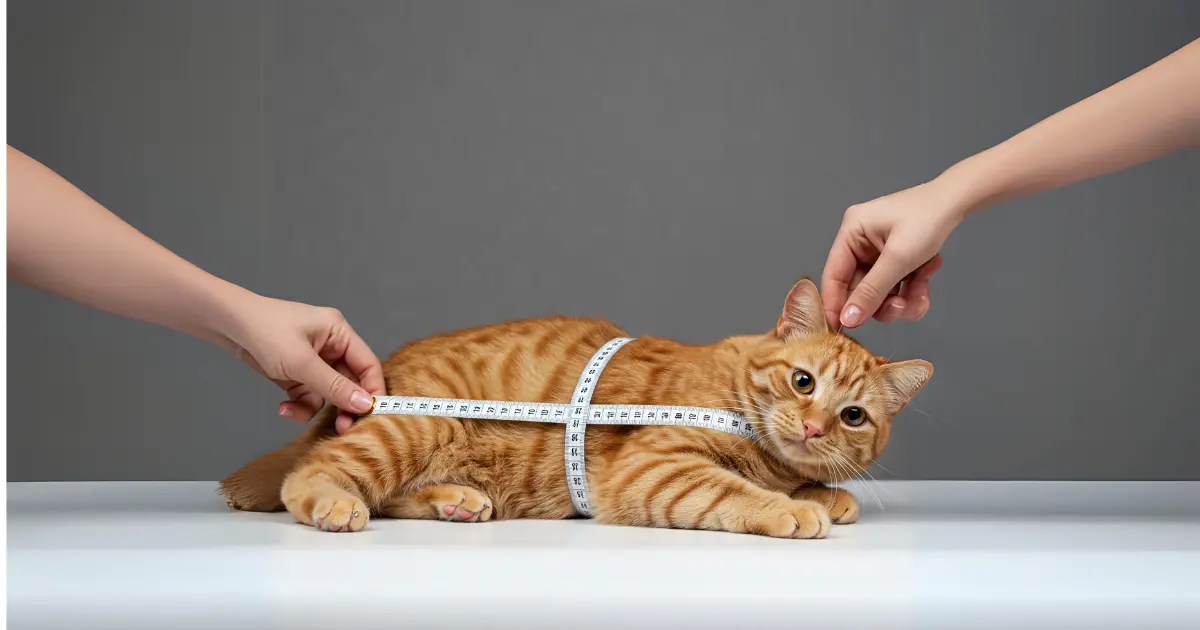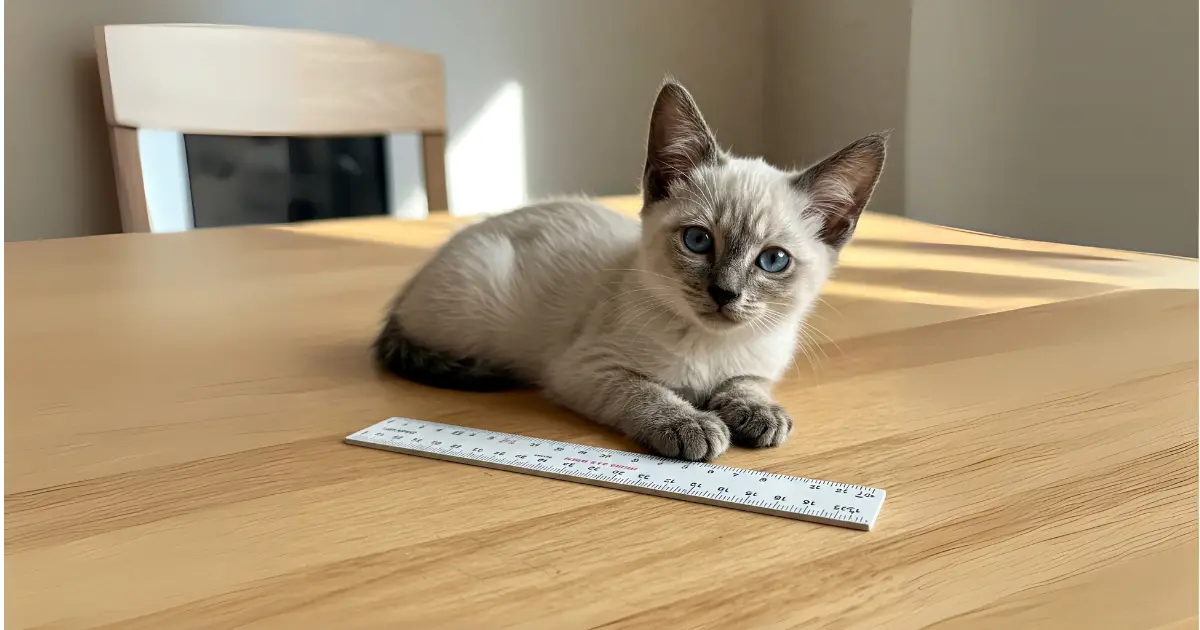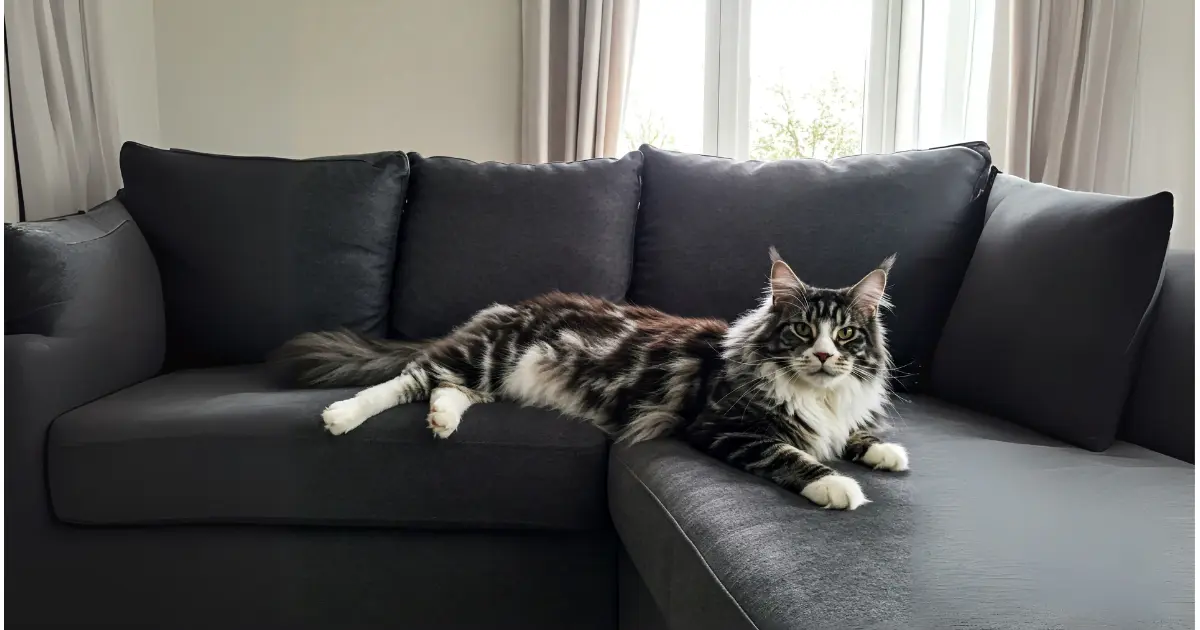Average Cat Length from Nose to Tail: Complete Guide
Published: 8 Feb 2025
Ever wonder how long your cat is from nose to tail? Knowing their length can come in handy! It’s good to see if you’re picking out accessories, keeping an eye on their growth, or just satisfying our curiosity about our pets. Plus, let’s face it—seeing how your furry friend stacks up is fun!

This guide covers average cat lengths, breed variations, growth factors, and fun facts, backed by expert veterinary insights and reliable sources like the American Veterinary Medical Association (AVMA) and The Cat Fanciers’ Association (CFA).
Table of Contents
What Does a Cat’s Length Include?
How to Measure a Cat’s Length?
Measuring your cat’s length isn’t rocket science, but it does require some patience (especially if your cat decides this is a game).
- Place the cat on a flat surface.
- Use a measuring tape from the tip of the nose to the end of the tail (while relaxed).
- Ensure your cat is calm and still—or as calm as a cat ever gets!
Tip: If your cat starts squirming, try measuring while it’s stretched out in its favourite sleeping position.
Reference: According to the CFA, full-body length measurements are standard in feline breed competitions (source).

Average Cat Length (Nose to Tail)
Most adult domestic cats measure 18 to 30 inches (45-76 cm) in total length. Tail length usually contributes 10-12 inches (25-30 cm).
| Category | Length Range (Nose to Tail) |
| Domestic Cats | 18-25 inches (45-64 cm) |
| Small Breeds (Siamese, Burmese) | 18-22 inches (45-56 cm) |
| Large Breeds (Maine Coon, Ragdoll) | 28-40 inches (71-101 cm) |
| Longest Recorded Domestic Cat | 48.5 inches (123 cm) |
Fun Fact: On the report of Guinness World Records, the longest domestic cat ever recorded was a Maine Coon named Stewie, measuring 48.5 inches (source). That’s longer than some toddlers!
Breed-Based Cat Length Differences
| Cat Breed Size | Breed Examples | Average Length | Fun Fact |
|---|---|---|---|
| Small to Medium Breeds | Siamese, Burmese, Abyssinian | 18-22 inches | Siamese cats are sleek but still compact, perfect for sneaking into tight spots (or your laptop keyboard). |
| Large & Giant Breeds | Maine Coon, Ragdoll, Savannah Cat | 30-40 inches | Maine Coons are over 3 feet long and love claiming your couch space. |
Kittens vs. Adult Cats
- Newborn kittens measure 3-5 inches.
- By 6 months, they reach 75% of their adult size.
- Growth is primarily complete by 12-18 months.

What Affects a Cat’s Length?
1. Breed & Genetics
Some breeds are naturally longer due to selective breeding. According to The International Cat Association (TICA), hybrid breeds like the Savannah Cat inherit their elongated body from their serval ancestors (source).
Tip: If you love long cats, consider breeds like the Oriental Shorthair—they look like elegant feline noodles.
2. Diet & Growth Development
A nutrient-rich diet is essential for skeletal development. Malnourished cats may remain smaller than expected. Learn more about Cat Nutrition and how the right food can promote healthy growth.
Tip: The AVMA recommends balanced protein intake to support muscle growth in developing cats (source). Want your kitten to grow big and strong? Ensure their food is packed with high-quality protein (and maybe a few treats here and there).
3. Tail Length & Proportions
Some cats have longer tails, while others have genetic traits leading to short tails (e.g., Manx cats).
Example: Savannah Cats have elongated frames and tails, making them appear extra long—and incredibly majestic.

Why Does Knowing a Cat’s Length Matter?
Here are a couple of reasons:
1. Picking the Right Accessories
Regarding carriers, beds, or scratching posts, size matters for your cat’s comfort. For example, large breeds like Maine Coons need extra spacious carriers to travel comfortably—trying to squeeze a 40-inch cat into a tiny one? Not fun for anyone! Getting the right-sized accessories for your cat can make a big difference in how comfortable they feel day-to-day. Not fun for anyone! Getting the right-sized accessories for your cat can make a difference in their everyday comfort.
2. Health Monitoring
If their growth seems off or they look slightly different, it could be a sign that something’s up with their diet or genes. Keeping an eye on their size helps you catch any issues early so you know they’re feeling good. How does that look now?
Measuring your cat might seem like a small thing, but it can really make a big difference in its well-being!
3. Fun Size-Related Facts
Wild relatives like cheetahs rely on long bodies for speed. Cats with extended frames often have greater agility (and a knack for knocking things off shelves from higher places).
Conclusion
Cats come in all shapes and sizes; breed, genetics, and diet can significantly affect their lifetime. Whether your cat’s a little ball of fluff or a sleek, long kitty, knowing their size can help you keep track of their health and pick out the right accessories. Why not grab a tape measure and find out how long your furry friend is today? I’d love to hear how they measure up—share it in the comments!
FAQ
1. What is the average house cat’s entire length?
Most domestic cats measure between 18-25 inches from nose to tail.
2. What’s the longest cat breed?
Maine Coons and Savannah Cats are among the longest breeds, often exceeding 30 inches.
3. Does a cat’s length affect its behavior?
While length doesn’t directly impact behavior, larger breeds like the Maine Coon are often more laid-back and social, while smaller breeds may be more energetic. However, individual personality traits still play a more significant role than size.
4. Can a cat’s length change if it’s not neutered or spayed?
especially if done at a young age. Cats tend to stop growing earlier when spayed or neutered, but it’s unlikely to alter their size drastically.
5. How does a cat’s body length affect its agility?
Longer cats, like the Savannah or Maine Coon, often have a better balance due to their proportionate body and tail lengths. However, agility also depends on muscle development, flexibility, and overall health.
6. Do cats with shorter tails grow smaller in length overall?
Not necessarily. While breeds like the Manx have shorter tails, this doesn’t always correlate with a shorter overall body length—body size is more influenced by breed and genetics.
7. Why do some cats look longer even if they’re not?
Some cats, like the Siamese, have slender, elongated bodies that create the illusion of being longer, even if their size doesn’t reflect it. Their build is more about proportions than overall length.
8. Can you tell a kitten’s adult size based on its length at birth?
It’s hard to predict with certainty since growth rates can vary. However, by 6 months, you’ll have a clearer idea, as most kittens are about 75% of their adult size by then.
9. Does a cat’s length impact how much food it needs?
While larger cats might require more food due to their size, it’s more important to feed your cat based on its activity level and age. A more active cat, regardless of size, will need more calories.
10. Can my cat’s length affect its comfort in specific spaces?
Large cats may struggle to fit comfortably in smaller spaces or furniture, like carriers and beds. For a smooth experience, choosing products that accommodate your cat’s entire length is essential.

- Be Respectful
- Stay Relevant
- Stay Positive
- True Feedback
- Encourage Discussion
- Avoid Spamming
- No Fake News
- Don't Copy-Paste
- No Personal Attacks



- Be Respectful
- Stay Relevant
- Stay Positive
- True Feedback
- Encourage Discussion
- Avoid Spamming
- No Fake News
- Don't Copy-Paste
- No Personal Attacks





